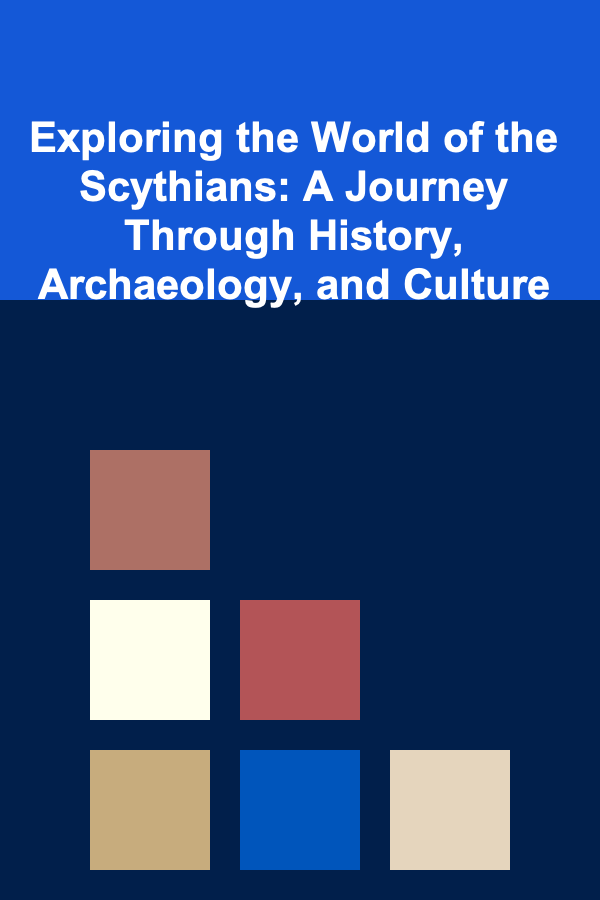
Exploring the World of the Scythians: A Journey Through History, Archaeology, and Culture
ebook include PDF & Audio bundle (Micro Guide)
$12.99$6.99
Limited Time Offer! Order within the next:

The Scythians, a nomadic warrior people who dominated the vast steppes of Eurasia from the 8th to the 3rd centuries BCE, remain an enigma shrouded in myth and archaeological wonder. Their impact on the ancient world was profound, influencing the cultures and empires they encountered, leaving behind a legacy of exquisite goldwork, equestrian prowess, and a captivating, if often violent, way of life. Exploring the world of the Scythians is a fascinating journey into a vanished civilization, demanding an interdisciplinary approach that blends historical accounts, archaeological findings, and a deep appreciation for the cultural context of their time.
Unveiling the Scythians: A Multifaceted Approach
Understanding the Scythians requires piecing together fragmented evidence from diverse sources. No single Rosetta Stone unlocks their secrets; instead, we must weave together the threads of ancient Greek writings, archaeological discoveries, and comparative analyses of related nomadic cultures to build a comprehensive picture.
Herodotus: Our Primary (Yet Imperfect) Window
The primary literary source for understanding the Scythians is the writings of Herodotus, the 5th-century BCE Greek historian often hailed as the "Father of History." In his Histories, Herodotus dedicates a significant portion to describing the Scythians, their customs, geography, and interactions with the Greek world. He provides invaluable information about their tribal divisions, religious beliefs, burial practices, and military strategies.
However, it's crucial to approach Herodotus' account with a critical eye. He relied on secondhand information, often gathered from Greek merchants and travelers who may have had limited exposure to the Scythian interior. Furthermore, Herodotus undoubtedly interpreted Scythian culture through a Greek lens, potentially misrepresenting or misinterpreting certain aspects. His penchant for colorful anecdotes and sensational stories also requires careful consideration.
Despite these limitations, Herodotus remains an indispensable source. He describes the Scythians' unique rituals, such as the drinking of the blood of slain enemies, their veneration of the god Ares (represented by a sword), and their elaborate burial mounds (kurgans). He also recounts their famous scorched-earth tactics employed against the Persian king Darius I, a campaign that ultimately led to the Persians' retreat.
Archaeological Excavations: Revealing Material Culture
Archaeology provides a tangible connection to the Scythians, offering concrete evidence of their material culture and lifestyle. The discovery of numerous kurgans, particularly those in southern Russia and Ukraine, has yielded a wealth of artifacts, including weapons, horse trappings, jewelry, and even mummified remains. These findings offer insights into their craftsmanship, social hierarchy, and burial rituals.
Key archaeological sites that have significantly contributed to our understanding of the Scythians include:
- Pazyryk (Altai Mountains): The frozen tombs of Pazyryk, located in the Altai Mountains of southern Siberia, are renowned for their exceptionally well-preserved artifacts, including textiles, wooden objects, and even tattooed bodies. The permafrost environment has acted as a natural preservative, allowing archaeologists to study objects that would otherwise have decayed over time. The Pazyryk finds reveal a sophisticated level of artistry and craftsmanship, demonstrating the Scythians' skill in creating intricate designs and working with various materials.
- Chertomlyk (Ukraine): This large kurgan in Ukraine is one of the most famous Scythian burial mounds. Excavations have uncovered a rich array of grave goods, including gold ornaments, weapons, and pottery. The Chertomlyk finds provide valuable insights into the Scythian elite and their funerary practices. The sheer scale of the kurgan and the opulence of the grave goods suggest a powerful and wealthy ruling class.
- Tillya Tepe (Afghanistan): While not strictly Scythian, the "Hill of Gold" at Tillya Tepe provides a fascinating glimpse into the cultural exchange between nomadic peoples and settled civilizations. This site contains the graves of six wealthy nomads, likely members of a Saka group (closely related to the Scythians), who were buried with an astonishing collection of gold jewelry and other artifacts. The Tillya Tepe treasure demonstrates the interconnectedness of the ancient world and the flow of goods and ideas across vast distances.
- Issyk Kurgan (Kazakhstan): Famous for the "Golden Man," a warrior buried in full regalia of gold armor, this kurgan offers a glimpse into the early Saka culture, closely related to the Scythians. The discovery of the Golden Man provided a powerful symbol of Kazakh national identity and highlighted the rich history of the region. The intricate craftsmanship of the gold armor showcases the advanced metalworking skills of the Saka people.
The analysis of skeletal remains found in Scythian graves also provides valuable information about their diet, health, and social structure. Isotopic analysis of bone can reveal their primary food sources, while examination of skeletal trauma can shed light on their experiences with warfare and violence. Furthermore, DNA analysis is increasingly being used to trace the genetic origins and migrations of the Scythians.
Scythian Society and Culture: Nomadic Warriors and Skilled Artisans
The Scythians were a complex society characterized by a nomadic lifestyle, a strong warrior ethos, and a remarkable artistic sensibility. Their culture was deeply intertwined with their environment and their constant interaction with neighboring civilizations.
Nomadic Pastoralism and Equestrian Prowess
The foundation of Scythian society was nomadic pastoralism. They were skilled horsemen and cattle herders, constantly migrating across the steppes in search of fresh pastures for their animals. Their mastery of horsemanship was legendary, allowing them to effectively wage war and control vast territories. The Scythians developed specialized equipment for riding and warfare, including the recurve bow, which was significantly more powerful and accurate than the simpler bows used by many of their contemporaries.
Their nomadic lifestyle shaped their social structure. They were organized into tribes and clans, each with its own territory and leadership. While egalitarianism likely existed at lower levels of society, a clear social hierarchy emerged, with a powerful warrior elite controlling wealth and influence. Burial mounds reveal significant differences in the quality and quantity of grave goods, indicating varying levels of social status.
Warfare and Military Tactics
The Scythians were formidable warriors, feared by their neighbors. Their military tactics were based on mobility and speed. They were skilled archers on horseback, able to launch devastating volleys of arrows at their enemies. Their famous scorched-earth strategy, employed against Darius I, proved highly effective in preventing invasion and protecting their territory. They were also known for their ferocity in battle and their custom of taking trophies from slain enemies.
Herodotus describes various Scythian war customs, including the drinking of the blood of the first enemy killed in battle and the use of scalps as decorative items. While these accounts may be exaggerated, they suggest a culture deeply immersed in warfare and violence.
Art and Material Culture
Despite their nomadic lifestyle, the Scythians were skilled artisans who produced exquisite works of art. Their most famous creations are the gold objects found in their kurgans. These objects often depict animals, particularly horses, deer, and felines, in a distinctive style known as "animal style." The animal style is characterized by stylized representations of animals, often with exaggerated features and intricate ornamentation. These images likely held symbolic meaning, reflecting the Scythians' beliefs about the natural world and their connection to the animal kingdom.
Scythian art was not limited to goldwork. They also produced fine examples of metalworking, pottery, and textiles. The Pazyryk carpet, found in one of the frozen tombs, is one of the oldest and most beautifully preserved carpets in the world. It demonstrates the Scythians' skill in weaving and their sophisticated sense of design.
The Scythians' art and material culture were influenced by their interactions with other civilizations. They borrowed motifs and techniques from the Greeks, Persians, and other neighboring peoples. However, they adapted these influences to create a unique and distinctive artistic style that reflects their own cultural identity.
Religion and Beliefs
Scythian religion was a complex mix of animism, ancestor worship, and shamanism. They venerated a pantheon of gods and goddesses, each associated with different aspects of nature and human life. Herodotus identifies several Scythian deities, including Tabiti (Hestia), Papaios (Zeus), Api (Gaia), and Ares (the god of war). They also worshipped a goddess associated with fertility and agriculture.
Their burial practices provide insights into their beliefs about the afterlife. The elaborate grave goods found in their kurgans suggest a belief in the importance of providing the deceased with everything they would need in the next world. The presence of horses and other animals in the graves indicates a belief that these creatures would accompany the deceased on their journey to the afterlife. The practice of burying servants and concubines alongside their rulers further suggests a hierarchical view of the afterlife, mirroring the social structure of the living world.
Interactions with the Ancient World: From Conflict to Cultural Exchange
The Scythians were not isolated from the rest of the ancient world. They interacted with numerous civilizations, including the Greeks, Persians, and other nomadic groups. These interactions ranged from conflict and conquest to trade and cultural exchange.
The Scythians and the Greeks
The Scythians had a complex relationship with the Greeks. They traded with Greek colonies along the Black Sea coast, exchanging grain, furs, and slaves for wine, pottery, and manufactured goods. However, they also engaged in conflict with the Greeks, raiding their settlements and disrupting their trade routes. The Greek historian Herodotus provides a detailed account of the Scythians' interactions with the Greeks, offering insights into their cultural differences and their mutual dependence.
The Greeks were fascinated by the Scythians' exotic customs and their reputation as fierce warriors. Greek artists often depicted Scythians in their artwork, portraying them as both barbaric and noble. The Scythians also influenced Greek culture, particularly in the areas of horsemanship and warfare. The Greek mercenaries who served in the Scythian army learned valuable military tactics and techniques that they later used in their own armies.
The Scythians and the Persians
The Scythians also had significant interactions with the Persians. In the late 6th century BCE, the Persian king Darius I led an army into Scythia in an attempt to conquer the region. However, the Scythians employed their scorched-earth tactics, avoiding direct confrontation and harassing the Persian army until it was forced to retreat. This campaign, though ultimately unsuccessful for the Persians, provides valuable insights into Scythian military strategy and their ability to resist powerful empires.
Despite the conflict between the Scythians and the Persians, there was also evidence of cultural exchange. Scythian art shows Persian influences, and some Scythian nobles adopted Persian customs and attire. The two cultures coexisted and interacted for centuries, influencing each other in various ways.
The Scythians and Other Nomadic Groups
The Scythians were part of a larger network of nomadic peoples who inhabited the Eurasian steppes. They interacted with other nomadic groups, such as the Sarmatians, the Saka, and the Massagetae. These interactions often involved conflict and competition for resources, but also led to cultural exchange and alliances. The Sarmatians, in particular, eventually displaced the Scythians from their territory in the 3rd century BCE, marking the decline of Scythian power.
The Legacy of the Scythians: Echoes in History and Culture
Although the Scythian empire eventually declined and disappeared, their legacy continues to resonate in history and culture. They left a lasting impact on the cultures of the peoples they interacted with, and their story continues to fascinate scholars and enthusiasts today.
Influence on Successor Nomadic Groups
The Scythians' equestrian skills, military tactics, and artistic traditions influenced subsequent nomadic groups who inhabited the Eurasian steppes. The Sarmatians, who eventually displaced the Scythians, adopted many of their customs and practices. The Huns, who migrated westward in the 4th and 5th centuries CE, also drew upon the Scythians' legacy of horsemanship and warfare.
Cultural Memory and Mythology
The Scythians have become romanticized figures in literature and mythology. They are often portrayed as fierce warriors, skilled horsemen, and noble savages. Their image has been used to symbolize freedom, independence, and the spirit of the steppes.
The myths and legends associated with the Scythians have also influenced art and literature. The story of the Amazons, female warriors who are said to have lived in Scythia, has captured the imagination of artists and writers for centuries. The Scythians' exotic customs and their reputation for ferocity continue to fascinate and inspire.
Modern Archaeological and Historical Research
Modern archaeological and historical research continues to shed new light on the Scythians. New discoveries and advanced technologies are providing a more nuanced understanding of their culture, society, and interactions with the ancient world. Ongoing excavations of kurgans are uncovering new artifacts and revealing new insights into their burial practices. DNA analysis is helping to trace their genetic origins and migrations. Historical research is re-evaluating ancient sources and providing new interpretations of Scythian history.
The study of the Scythians remains a dynamic and evolving field, with new discoveries and interpretations constantly challenging our understanding of this fascinating and enigmatic civilization. As technology advances and more research is conducted, our picture of the Scythians will undoubtedly become even richer and more detailed.
Conclusion: A Continuing Quest for Understanding
Exploring the world of the Scythians is a challenging but rewarding endeavor. By combining historical accounts, archaeological findings, and comparative analyses, we can begin to piece together a picture of this vanished civilization. While many mysteries remain, the Scythians offer a compelling glimpse into the lives and cultures of the nomadic peoples who shaped the ancient world. Their story reminds us of the complexity and interconnectedness of human history and the enduring power of culture to transcend time and space.
The journey into the world of the Scythians is far from over. Ongoing research and new discoveries promise to reveal even more about this fascinating people. As we continue to explore their legacy, we can gain a deeper understanding of the human experience and the diverse cultures that have contributed to the rich tapestry of our world.

5 Simple Steps for Lowering Homeowner's Insurance Premiums and Saving More
Read More
How to Incorporate Natural Elements into Your Wellness Space
Read More
How to Manage Pet Anxiety and Stress at Home
Read More
How to Use Project Management Tools for Paperwork Control
Read More
How To Practice Deep Work for Maximum Productivity
Read More
10 Tips for Perfect Swirling in Soap Making
Read MoreOther Products

5 Simple Steps for Lowering Homeowner's Insurance Premiums and Saving More
Read More
How to Incorporate Natural Elements into Your Wellness Space
Read More
How to Manage Pet Anxiety and Stress at Home
Read More
How to Use Project Management Tools for Paperwork Control
Read More
How To Practice Deep Work for Maximum Productivity
Read More